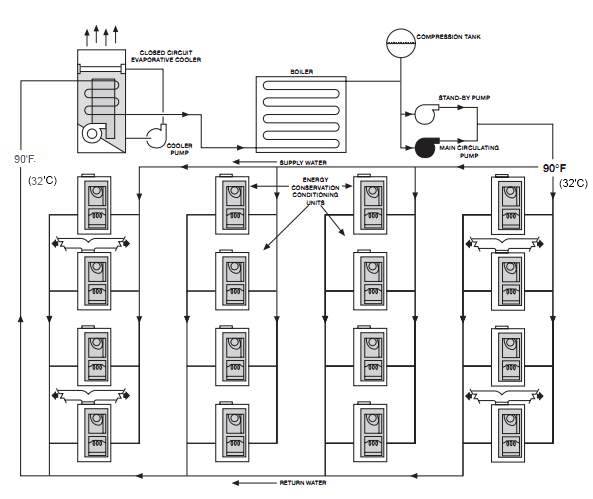|
Water source heat pump systems consist of multiple
water source heat pump (WSHP) units, a
building piping loop, cooling tower, and boiler. The
WSHP units themselves are water-to-air heat pumps
comprised of a compressor, water/refrigerant heat
exchanger, airside coil (refrigerant/air heat
exchanger), reversing valve, fan section, filters,
drain pan, and cabinet. WSHP units are available in
many configerations including horizontal units for
above the ceiling applications, small and large
vertical units, rooftop units, and console units.
All the unit configurations except the console units
require a ductwork system for delivering conditioned
air to the space. Console units are rarely ducted
through the outside wall for ventilation air in this
climate because air entering the WSHP units should
be above 60° F. (15'C)
|
Water Source Heat Pump (WSHP) systems are one
of the most efficient, environmentally friendly
ways to heat and cool buildings because each
unit responds only to the heating or cooling
load of the individual zone it serves. These
systems are ideal for office buildings, hotels,
health care facilities, banks, schools, condominiums
and apartments.
Water source heat pumps remain a revolutionary
concept for their simplicity and outstanding
energy performance.
Water source heat pump (WSHP) systems share
the ability to move energy from where it is
not needed to where it is needed with other
sophisticated HVAC systems. The nergy is moved
in water, which is very effective and requires
minimal transport (pump) work.
Figure shows how WSHPs can move energy around
a building. In a WSHP system, high efficiency,
self-contained units can be placed in virtually
any location within a building and connected
via a water loop. Heat is added and rejected
from the loop using a boiler and cooling tower,
or by using natural sources such as the ground,
a well or a pond. Each unit esponds only to
the individual cooling or heating load of the
individual zone they serve. This results in
close control over the temperature and humidity
in each building zone, which leads to excellent
occupant comfort. Energy use is kept to a minimum
because units will generally only operate when
there is a call for heating or cooling in their
specific zone. In fact, in milder ambient conditions,
the units may operate for only a short period
of time during occupied hours.
|
 |
Building Water Loop:
Each zone or space will have one or more WSHP units
which are connected to a two pipe water loop (one
supply pipe and one return pipe). The heat pump units
either reject heat to or extract heat from the piping
loop depending on whether they are cooling or heating
the space. This system will therefore recover and
redistribute heat when some of the units are in the
heating mode and other units are in the cooling mode.
This is an advantage particularly where there is an
interior building core which requires year around
cooling, and a perimeter zone where heating is required
in the winter. Rejected heat from daytime cooling
requirements can also be used for nighttime heating
requirements when thermal storage is provided.
The Advantages of Using Water
Water is the most efficient way to move thermal energy.
For
example, a 51 mm water pipe can carry the same amount
of cooling as a 610 mm air duct, requiring up to 90%
less
transport energy in the process and taking up far
less space.
The mass of the water loop also provides thermal storage,
allowing a substantial amount of heat to be carried
from
occupied periods into morning warm-up. There is no
storage
benefit in most HVAC systems.
Water-source heat pump heat exchangers are more compact
and efficient than air-cooled heat exchangers because
the much higher mass and thermal conductivity of water,
providing closer approach temperatures and higher
heat
pump efficiencies. Water-source heat pumps also operate
at
lower condensing temperatures because they are linked
to
the outdoor wet bulb temperature (using a cooling
tower) or
the deep earth temperature (using a ground heat exchanger)
instead of the higher outdoor dry bulb temperature,
again
leading to higher efficiencies and longer s
The piping loop is kept between 60° F(15'C)
and 90° (32'C) pump operation. The piping loop
therefore does not need to be insulated which is a
cost savings.
|

